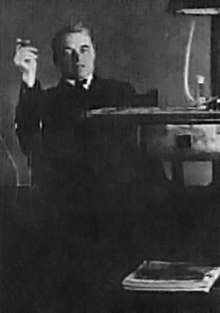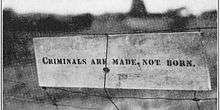Andrew Kehoe
| Andrew Kehoe | |
|---|---|
 Photo taken c. 1920 | |
| Born |
Andrew Phillip Kehoe February 1, 1872 Tecumseh, Michigan, U.S. |
| Died |
May 18, 1927 (aged 55) Bath Township, Michigan, U.S. |
| Cause of death | Suicide (explosives) |
| Occupation | Farmer, school board member, treasurer |
| Spouse(s) |
Ellen Agnes "Nellie" Price (m. 1912; murdered 1927) |
| Details | |
| Date | May 18, 1927 |
| Location(s) | Bath Township, Michigan |
| Target(s) | Bath Consolidated School |
| Killed | 44 |
| Injured | 58 |
| Weapons | Explosives (dynamite, firebombs, pyrotol) |
Andrew Philip Kehoe (February 1, 1872 – May 18, 1927) was an American farmer and treasurer of his township school board, notable as a mass murderer for killing his wife and 43 other people (including 38 children), and injuring 58 people by setting off bombs in the Bath School disaster on May 18, 1927. He committed suicide near the school by detonating dynamite in his truck, causing an explosion which killed several other people and wounded more. He had earlier set off incendiary devices in his house and farm, destroying all the buildings, as well as killing two horses and other animals.
Early life and education
Kehoe was born in Tecumseh, Michigan, among the younger of a family of 13 children. His parents were Philip Kehoe (1833–1915) and Mary (McGovern) Kehoe (1835–1890).[1] He attended Tecumseh High School and Michigan State College (later Michigan State University), where he studied electrical engineering. There, he first met his future wife, Ellen "Nellie" Price, the daughter of a wealthy Lansing family.[2]
After college, Kehoe went south west, apparently working for several years as an electrician in St. Louis, Missouri. During this period, in 1911, he suffered a severe head injury in a fall[3] which resulted in his being in a coma for two weeks.[4]
Kehoe then moved back in with his father after the injury. He had been away from the family home for several years. During that time and after his mother's death his father married Frances Wilder. On September 17, 1911, Frances was severely burned when the family's stove exploded as she was attempting to light it. The fuel soaked her, with her body catching fire. Kehoe threw water from a nearby bucket on her; due to the oil-based nature of the fire, the water did nothing to put the flames out. Frances later died from her injuries with allegations being made that the stove had been tampered with.[5][6][lower-alpha 1]
Marriage and family
After his return to Michigan, in 1912 he married Nellie Price. In 1919 the couple bought a 185-acre (750,000 m2) farm outside the village of Bath[8][9] from Nellie's aunt for $12,000. He paid $6,000 in cash and took out a $6,000 mortgage.[2]
Personality
Kehoe was regarded by his neighbors as a highly intelligent man who grew impatient and angry with those who disagreed with him. Neighbors recalled that Kehoe was always neat, dressed meticulously, and was known to change his shirt at midday or whenever it became even slightly dirty. Neighbors also recounted how Kehoe was cruel to his farm animals, having once beaten a horse to death.[7] The Kehoes initially attended services at the Catholic church in Bath, but he refused to pay the church's parish assessment of members and prevented his wife from attending.[7]
Kehoe's neighbors thought he preferred mechanical tinkering to farming. His neighbor M. J. "Monty" Ellsworth wrote in his account of the disaster,
He never farmed it as other farmers do and he tried to do everything with his tractor. He was in the height of his glory when fixing machinery or tinkering. He was always trying new methods in his work, for instance, hitching two mowers behind his tractor. This method did not work at different times and he would just leave the hay standing. He also put four sections of drag and two rollers at once behind his tractor. He spent so much time tinkering that he didn't prosper.[7]
Bath Consolidated School administration
With a reputation for thrift, Kehoe was elected treasurer of the Bath Consolidated School board in 1924. While on the board, Kehoe fought for lower taxes and was often at cross purposes with other board members, voting against them and calling for adjournment when he did not get his way. He repeatedly accused superintendent Emory Huyck of financial mismanagement.[7]
While on the school board, Kehoe was appointed as the Bath Township Clerk in 1925 for a short period. In the spring 1926 election, he was defeated for the position, and was angered by his public defeat. His neighbor Ellsworth thought Kehoe started planning his "murderous revenge" against the community at that time. Another neighbor, A. McMullen, noticed that Kehoe stopped working altogether on his farm in his last year, and thought he might be planning suicide.[7]
During these years, Nellie Kehoe was chronically ill with tuberculosis, and had frequent hospital stays - at the time there was no effective treatment or cure for the disease. By the time of the Bath School disaster, Kehoe had ceased making mortgage and homeowner's insurance payments. The mortgage lender had begun foreclosure proceedings against the farm.[7][10][11]
Bath School disaster
The Bath School disaster is the name given to a series of explosions perpetrated by Kehoe on May 18, 1927, in Bath Township, Michigan, which killed 45 people (including Kehoe himself) and injured at least 58. Most of the victims were children in the second to sixth grades (7–12 years of age) attending the Bath Consolidated School. Their deaths constitute the deadliest act of mass murder in a school in U.S. history.
Between May 16, when he returned home from a hospital stay, and the morning of May 18, Kehoe killed his wife. He moved her body to a farm building before setting off incendiary explosions in their house and farm buildings. About the same time, he had arranged timed explosions in the new school building. The materials in the north wing exploded as planned, killing many students and some adults inside. Kehoe had set a timed detonator to ignite dynamite and hundreds of pounds of pyrotol at the school, which he had secretly bought and planted in the basement of both wings over the course of many months. The second 500 pounds (230 kg) of explosives in the south wing did not detonate, so that part of the school was not destroyed.
As rescuers started gathering at the school, Kehoe drove up and stopped his truck. During a struggle with Superintendent Huyck, Kehoe detonated dynamite stored inside his shrapnel-filled truck, killing himself and Huyck, as well as killing and injuring several others (among them a boy who had survived the initial bombing).[12] During the rescue efforts, searchers discovered the additional 500 pounds (230 kg) of unexploded dynamite and pyrotol planted throughout the basement of the school's south wing. These explosives, connected to an alarm clock that was supposed to act as the detonator, had been set for the same time as the other explosion.

After the bombings, investigators found a wooden sign wired to the farm's fence with Kehoe's last message, "Criminals are made, not born", stenciled on it.[10] When investigators were done taking an inventory of the Kehoes' estate, they estimated that, prior to its destruction, sale of the unused equipment and materials on the farm would have yielded enough money to pay off the Kehoes' mortgage.
One of Kehoe's sisters claimed his remains and arranged for burial without ceremony in an unmarked grave at Mount Rest Cemetery in St. Johns, Michigan.[13] The Price family claimed Nellie's remains and had her body buried in Lansing, under her maiden name.[14]
See also
Notes
References
- ↑ Daggy, J.L. "The Bath School Disaster: Andrew Philip Kehoe - Farmer, School Board Treasurer, Bomber". Daggy.Com. Retrieved May 14, 2016.
- 1 2 Grant Parker (1980). Mayday: History of a Village Holocaust. Parker Press. p. 27. Retrieved December 17, 2012.
- ↑ Mike Mayo (February 1, 2008). American Murder: Criminals, Crime, and the Media. Visible Ink Press. p. 175. ISBN 978-1-57859-191-6. Retrieved December 17, 2012.
- ↑ "Interview with Arnie Bernstein" (PDF). University of Michigan Press. 2009. Retrieved August 4, 2017.
...an accident that put him in a coma for two weeks
- ↑ Arnie Bernstein (2009). "Chapter Two - Andrew P. Kehoe". Bath Massacre: America's First School Bombing. The University of Michigan Press. ISBN 978-0-472-11606-5.
- ↑ "Frances Kehoe Death Certificate". Seeking Michigan. Michigan History Foundation. September 19, 1911. Retrieved May 31, 2017.
- 1 2 3 4 5 6 7 Monty J. Ellsworth (1927). "Chapter Three — Life of Andrew Kehoe". The Bath School Disaster. Retrieved December 17, 2012.
- ↑ Ellsworth, Monty J. (1927). "Chapter One—The Bath Consolidated School" (online version). The Bath School Disaster. Bath School Museum Committee (1991 ed.). OCLC 6743232. Retrieved April 13, 2011.
- ↑ Parker, Grant (1992). Mayday, History of a Village Holocaust. Liberty Press. p. 27. ISBN 0-9604958-0-0.
- 1 2 "School Dynamiter First Slew Wife". New York Times (via Bauerle FreePages @ RootsWeb.com). May 20, 1927. Retrieved January 15, 2013.
- ↑ Ellsworth, Monty J. (1927). "Chapter Three—Life of Andrew Kehoe" (online version). The Bath School Disaster. Bath School Museum Committee (1991 ed.).
- ↑ Burcar, Colleen (2011). It Happened in Michigan: Remarkable Events That Shaped History. Globe Pequot. Retrieved January 15, 2013.
- ↑ Daggy, J.L. "Andrew Philip Kehoe, Farmer, School Board Treasurer, Bomber". Daggy Space Website.
- ↑ Daggy, J.L. "Ellen Agnes Price Kehoe Murder Victim; wife of School Bomber". Daggy Space Website.